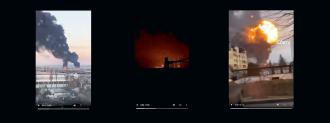Tricia White and Ben Mueller are watching a traffic jam on Google Maps. It inches down the road, reaching from around the Russian city of Belgorod to the Ukrainian border. But it is 3:15 in the morning there.
It is in the exact same place that formations of Russian military vehicles had been spotted the night before, according to a tweet by Jeffrey Lewis.
Lewis, White, and Mueller are not spies or military intelligence analysts. Lewis is Middlebury Institute professor — where White is a graduate research assistant and Mueller also studies — and director of the East Asia Nonproliferation Project.
Google Maps may have predicted an invasion.
Their knowledge of Russian armor, arrayed in columns as if ready to move, did not come from a mole, cloak-and-dagger operation, or a spy satellite. It came from an image captured by Capella Space, a private satellite company, Lewis tweets.
What is unfurling across Twitter and other social media spaces is the power of publicly available information. Known as open source intelligence, or OSINT, it can be viewed by anyone, if they know where to look, and analyzed by anyone, if they know what to look for.
Search engines, social media, and AI algorithms have made OSINT more accessible, available, and important than ever before.
More than ever before, war is now playing out in real time before the world’s eyes — unfiltered by media or governments.
“Journalists, from correspondents and embeds to combat photographers, have been a vestige of warfare in the latter 20th century,” Craig Nazareth, assistant professor of Practice of Intelligence & Information Operations at the University of Arizona, tells me via email.
“This is a new dynamic we began witnessing after the fall of the Berlin Wall — democratized internet and tools.”
A little over an hour after Lewis’ initial tweet, Mueller tweets that the “traffic jam” has appeared to cross the Ukrainian border.
Google Maps may have predicted an invasion.
Open-source spies: New tools and technology have led to a revolution in OSINT.
“Social media, big data, smartphones and low-cost satellites have taken center stage, and scraping Twitter has become as important as anything else in the intelligence analyst toolkit,” Nazareth wrote in The Conversation.
“These technologies have also allowed news organizations and armchair sleuths to follow the action and contribute analysis” — making intelligence no longer purely the domain of governments and militaries.
OSINT helped paint a more accurate picture of events during Russia’s military buildup on Ukraine’s borders. Professional and amateur analysts both turned to publicly available satellite data and TikTok videos to track troop movements, NBC reported.
Instagram and TikTok have become important platforms for sharing military-related videos, defense analyst Konrad Muzyka told NBC. Muzyka had used social media footage — some of it from Russian soldiers themselves — to track the movement of Russian military equipment.
By examining the markings on military vehicles, Muzyka could determine what regiment or brigade they belong to, and he used train station data to track their locations.
Open source intelligence, or OSINT, can be viewed by anyone if they know where to look, and analyzed by anyone if they know what to look for, providing a real-time picture of war.
Anonymous analyst “ELINT News,” a British international relations student who monitors OSINT as a hobby, told FRANCE 24 how he used open source data to put together accurate reports of Russian movements ahead of the invasion.
“In the case of the Russian-Ukrainian crisis, it usually starts with a TikTok video,” ELINT said. “It’s a surprisingly useful platform for finding videos of the Russian army’s train movements.”
Publicly accessible websites tell ELINT where trains in geotagged videos left from or arrived at, and he then uses public satellite image platforms to see if military encampments had grown or shrunk.
“This is probably one of the first times in history that people are seeing what the Russians are doing so quickly,” ELINT said.
Even a quick glimpse of a license plate can help dedicated sleuths figure out where military vehicles are headed.
As satellites and drones become cheaper, companies without the resources of an entire nation can operate them, and the proliferation of smartphones means that eyes on the ground are always watching, as well. Bringing these sources of information together is the internet, which also allows for collating, analysis, and sharing that analysis.
According to Nazareth, a combination of footage captured by private companies and individuals means that a wealth of information about a conflict is available to anyone willing to look for it — and that includes governments.
“Government OSINT typically provides 90% of the intelligence used for policymaking and national security related decisions,” Nazareth tells me via email.
“This situation is no different, especially since the U.S. government is using collection from a variety of non-government open sources to gain situational awareness, understanding, and confirmation of Russian intent and military posture, including damage inflicted on Ukrainian interests.”
“In the case of the Russian-Ukrainian crisis, it usually starts with a TikTok video.”
elint
A real-time invasion: The wealth of OSINT that helped to reveal Russian movements in the lead up to war now also provides us with a real-time picture of the war in motion.
Like CNN’s live footage of the first Persian Gulf War, people around the world could now see, from a variety of information sources and across channels like Twitter, an invasion unfold before their eyes.
“Publicly available information posted to a variety of media feeds provided everyone a play by play,” Nazareth says. OSINT will likely continue to play a role in how we view the war going forward.
Media information can be combined with footage from people on the ground and satellite imagery to confirm or deny what is being reported, and provide greater context, Nazareth says. Open source intelligence can also help inform classified intelligence.
“Publicly available information posted to a variety of media feeds provided everyone a play by play.”
Craig Nazareth
“Journalists, social media users, and Ukrainian cell phone users at the front lines are capturing useful information that would not otherwise be available to U.S. drones or satellites,” Nazareth says.
The OSINT analysis and sharing by amateurs, academics, and hobbyists may also play a role in countering disinformation campaigns.
“Users are sharing ‘evidence’ of Russia’s invasion, and adding insights to the discussion — this can hinder or help government information campaigns and their ability to convey their narrative,” Nazareth says.
But amongst all of that intelligence just waiting to be consumed is misinformation and disinformation, mistakes and propaganda. The same channels which make OSINT easier than ever to share and analyze also make it easier to share bad or false information.
However, it has also never been easier for hoaxes and misinformation to be rapidly fact-checked and debunked by amateur analysts, experts, journalists, and organizations like Bellingcat.
With our own eyes: In the wake of the overnight invasion, I turned to that intimately close information, too.
The footage is startling: a deep gray plume, a blinding orange and white bloom on top like a vicious flower. The explosion leaps into the overcast sky of Ivano-Frankivsk, a city in the west of Ukraine, almost as far from Russia as you can be. A man can be heard saying, “Two more again, I don’t know what is exploding there.”
A woman, distraught, yells something. We don’t need to know what she is saying to feel what she means.
“Journalists, social media users, and Ukrainian cell phone users at the front lines are capturing useful information that would not otherwise be available to U.S. drones or satellites.”
Craig Nazareth
The Telegram post, shared by Russian journalist Ilya Varlamov on his Varlamov News account, is an example of my own use of OSINT to get a glimpse of the real invasion. It is from the ground, not gathered by military intelligence, available to anyone who looks for it.
There’s more footage, which has not been independently verified by Freethink: Twin smoke columns curling above an airport in Chuguyev, near Kharkiv, Ukraine’s second largest city, and weapons popping like fireworks in the night around Mariupol, on the coast of the Sea of Azov.
In a new era of warfare where disinformation can be better weaponized than ever before and cyberattacks seek to make the world go blind, OSINT may become key to understanding what is happening, as it is happening, with thousands of eyes peering through the fog of war.
We’d love to hear from you! If you have a comment about this article or if you have a tip for a future Freethink story, please email us at tips@freethink.com.






